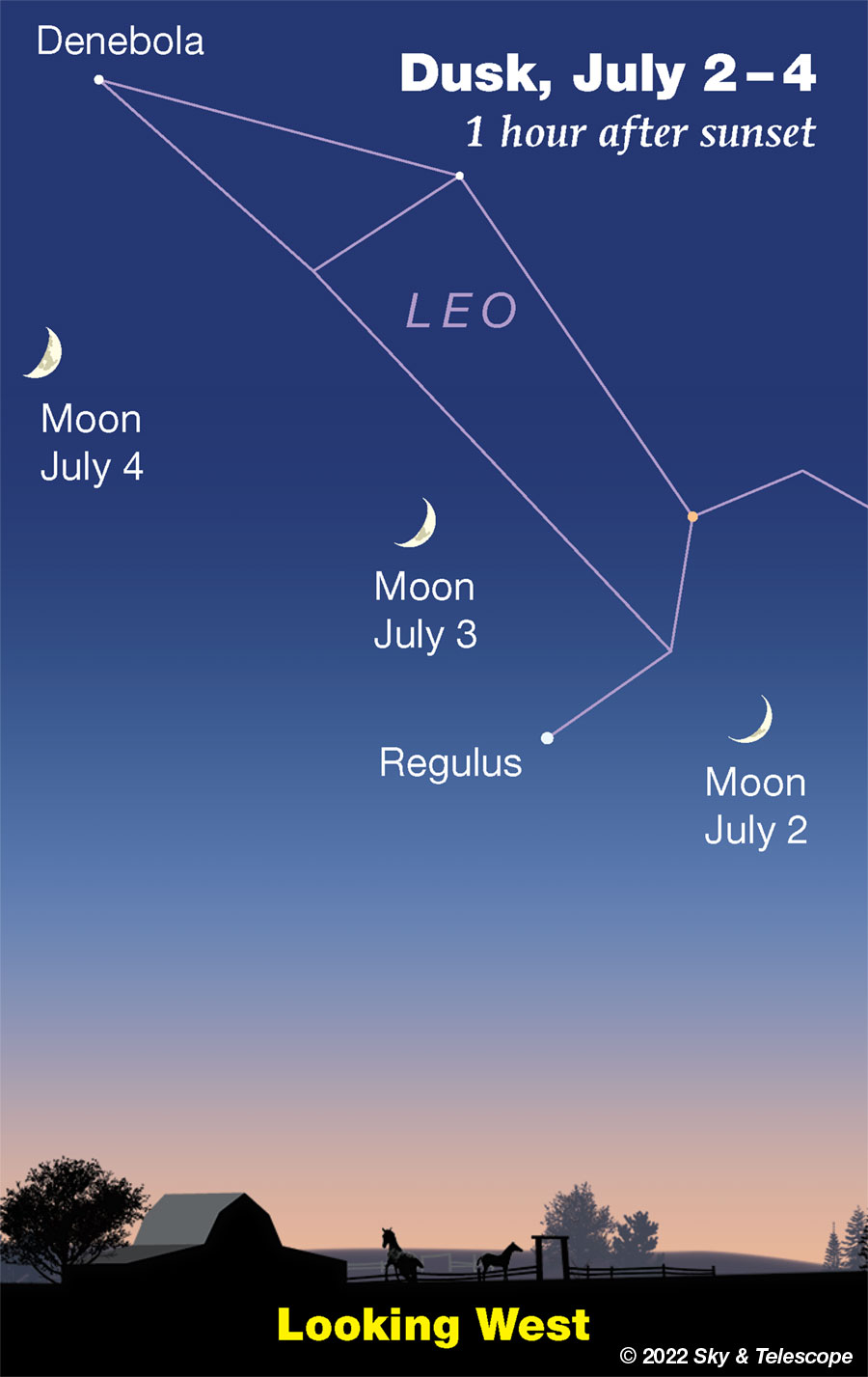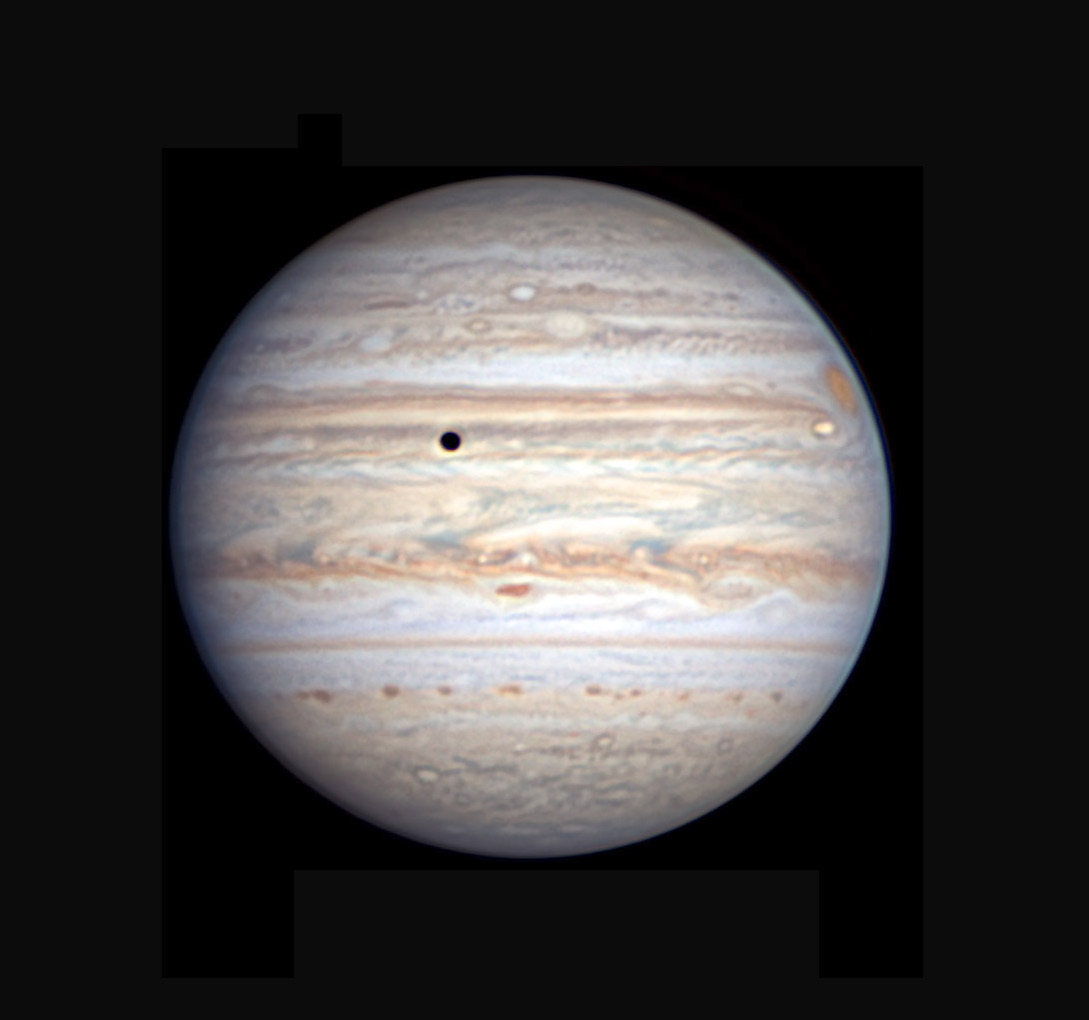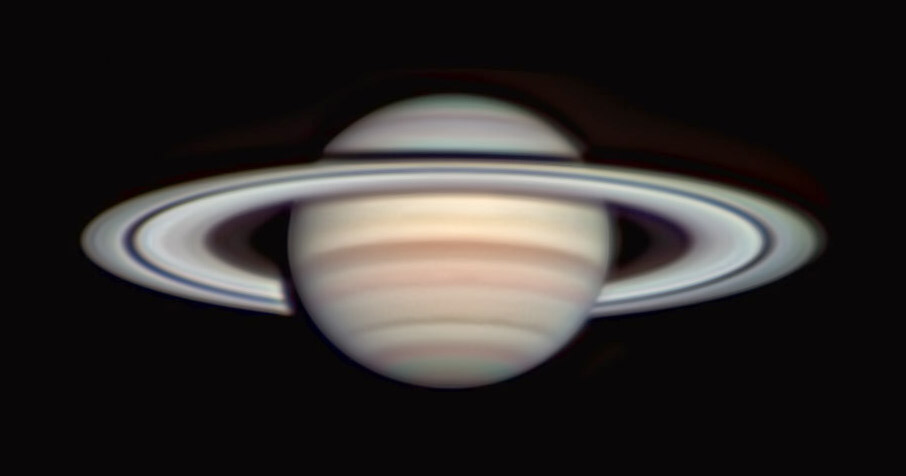FRIDAY, JULY 1
■ On the eastern side of the sky, the Summer Triangle holds sway after dark. Its top star is Vega, the brightest on that entire half of the sky. The brightest star to Vega's lower left is Deneb. Farther to Vega's lower right is Altair, with fainter Tarazed just above it. The Milky Way (if you have deep darkness) runs across the Triangle just inside its bottom edge.
As evening grows late and even Altair rises high, look left or lower left of Altair, by a bit more than a fist at arm's length, for the compact little constellation Delphinus, the Dolphin.
Did you get it? Then try for even fainter, smaller Sagitta, the Arrow. It's to Altair's upper left, just a little closer to Altair. The Arrow points lower left, past the nose of Delphinus.
SATURDAY, JULY 2
■ In twilight this evening, look west for the waxing crescent Moon. Left of the Moon is Regulus, and above the Moon is slightly fainter Algieba, Gamma Leonis, as shown below. Like last month, they form an isosceles (two-sides-equal) triangle.
Binoculars help reveal the color difference between the two stars. Also, Algieba is a wide optical double for binoculars and a much closer true binary (5 arcseconds) for telescopes.

SUNDAY, JULY 3
■ Again the Moon forms an isosceles triangle with Regulus and Algieba, but now it's on the opposite side of them, as shown above. This time, the triangle is also nearly equilateral (in the time zones of the Americas). How close to perfect the equilateral triangle is will depend on your time and place of observation.
MONDAY, JULY 4
■ Low in the northwest or north at the end of these long summer twilights, would you recognize noctilucent clouds if you saw them? They're the most astronomical of all cloud types, what with their extreme altitude and their formation (in part) on meteoric dust particles. They used to be fairly rare, but they've become more common in recent years as Earth's atmosphere changes. See Bob King's Nights of Noctilucent Clouds.
■ Earth is at the aphelion of its orbit, its farthest from the Sun for the year: 3% farther than at perihelion in January.
TUESDAY, JULY 5
■ To casual starwatchers or those who have an obstructed northern view, Cassiopeia in July might sound as wrong as Christmas in July. But already Cas has passed its lowest evening position of the year and is gradually gaining altitude in preparation for the coming fall and winter. Look for its flattened W shape low in the north-northeast after dark. It's no longer level.
WEDNESDAY JULY 6
■ First-quarter Moon (exact at 10:14 p.m. EDT). The Moon is in Virgo, with Spica to its left and fainter Gamma Virginis (Porrima) closer to its right or lower right. Brighter Arcturus shines very high above them.
Gamma Vir is a fine close double star for telescopes. Its current separation is 3 arcseconds, and the components are nearly equal in brightness. They're spectral type F0 V, somewhat larger and hotter than the Sun. They orbit each other in 169 years. They're 38 light-years away.
■ Arcturus and Vega are about equally far from straight overhead shortly after dark: Arcturus toward the southwest, Vega toward the east.
Arcturus is pale yellow-orange; Vega is icy bluish white. Star colors are mostly subtle, and different people have an easier or harder time seeing them. To me, the tints of bright stars show a little better in the dark blue of a late-twilight sky than in a fully dark sky.
For instance, compare Vega and Arcturus in twilight and after dark. Do their colors stand out a little better or worse for you one way or the other?
Binoculars, of course, always make star colors much more obvious.
THURSDAY, JULY 7
■ Now Spica shines lower right of the Moon.
■ Look very far left of Spica soon after dark, by 4 or 5 fists at arm's length, for orange Antares, equally bright. Just before you get to Antares you cross the head (or forehead) of Scorpius: the roughly vertical row of Beta, Delta, and fainter Pi Scorpii.
Delta Sco, the middle one, is the brightest of the three. It's an irregular variable star, a fast-rotating blue subgiant throwing off luminous gas from its equator. It also has a smaller orbiting companion that seems to trigger activity at 10.5-year intervals. Assumed for centuries to be stable, Delta unexpectedly doubled in brightness in July 2000 and has remained nearly that bright, with fluctuations, for many of the years since. Astronomers are waiting to see whether it will have another flareup any time now, as the companion makes its third pass by the primary star since 2000.
Delta Sco is currently about magnitude 1.9, pretty much where it has stayed for the last 11 years.
FRIDAY, JULY 8
■ Titan and its atmosphere to occult a star! David Dunham of the International Occultation Timing Association writes, "Titan, the 8th-magnitude moon of Saturn with a thick atmosphere, will occult a star of the same brightness on Saturday morning, July 9. The occultation will be visible from much of North America: south of the northern limit that crosses central California, the southeast corner of Idaho, and north of Winnipeg, Manitoba. The southern limit crosses northwestern South America. Titan will be 3 arcminutes east of Saturn [about 4 ring-diameters].
"The occultation will last up to 5.5 minutes, shorter especially near the limits. When Titan gets close enough to the star that the two appear to merge, they will appear as a single object of magnitude 7.9. Then, for several seconds, the object will gradually diminish in brightness as the star sinks into Titan’s atmosphere, eventually reaching the magnitude 8.5 of Titan alone as the star completely disappears. The merged objects will similarly brighten when the star reappears."
That decline of 0.6 magnitude will difficult to track by eye, "but can be recorded well with a sensitive video or CCD camera." Such recordings "will be able to measure Titan’s atmosphere at a unique latitude of the moon, possibly recording brightening spikes caused by inversion layers in the atmosphere, as have been recorded during many previous occultations by planets and satellites with atmospheres.
"Of special interest may be the central flash that will occur close to the occultation’s central line, when Titan’s entire atmosphere will focus the star’s light, causing it to brighten briefly well above its un-occulted level at central occultation."
Maps, a timetable for hundreds of locations, and more information are on IOTA's webpage for this event (updated).
"The next observable occultation of a similarly bright star by Titan won’t occur until 2048," writes Dunham, "and that will only be visible from Antarctica, so you are encouraged to make what observations you can of this rare event."
See also Bob King's Titan Occults a Bright Star (he calls magnitude 8.8 "bright"; I wouldn't). The article has a map of the eyepiece field including Saturn's other moons, and a timed video recording of Titan occulting a much brighter star in 1989.
SATURDAY, JULY 9
■ To the left of the waxing gibbous Moon, look for orange Antares and the rest of the pattern of upper Scorpius.
■ The Big Dipper, high in the northwest after dark, is turning around to "scoop up water" through the evenings of summer and early fall.
This Week's Planet Roundup
Mercury is dropping out of sight deep in the glow of sunrise.
Venus (magnitude –3.9) rises just as dawn begins. Look for it above the east-northeast horizon. It's very far lower left of bright Jupiter, by six or seven fists at arm's length.
Mars and Jupiter, very different at magnitudes +0.4 and –2.5 respectively, rise after midnight and shine in the east-southeast before and during early dawn. Mars is about two fists to Jupiter's lower left. They continue to move apart, week by week.

On this side of the planet, the South Equatorial Belt is currently divided into two thin dark lines. The North Equatorial Belt looks more turbulent than we've seen it recently, and it hosts a tiny white outbreak (cloud upsurge) near the central meridian. just above a dark red barge in the North Tropical Zone.
Saturn, magnitude +0.7 in Capricornus, rises in the east-southeast around the end of twilight. It's highest in the south for best telescopic viewing shortly before dawn (about 2 hours before sunrise).
The little star 1½° below or lower right of Saturn is Delta Capricorni, magnitude 2.8.

Uranus, magnitude 5.8 in Aries, is fairly low in the east before the first light of dawn, between Venus and Mars.
Neptune, magnitude 7.9 at the Aquarius-Pisces border, is high in the southeast before the first light of dawn, between Jupiter and Saturn.
All descriptions that relate to your horizon — including the words up, down, right, and left — are written for the world's mid-northern latitudes. Descriptions and graphics that also depend on longitude (mainly Moon positions) are for North America.
Eastern Daylight Time, EDT, is Universal Time minus 4 hours. (Universal Time is also called UT, UTC, GMT or Z time.)
Want to become a better astronomer? Learn your way around the constellations. They're the key to locating everything fainter and deeper to hunt with binoculars or a telescope.
This is an outdoor nature hobby. For an easy-to-use constellation guide covering the whole evening sky, use the big monthly map in the center of each issue of Sky & Telescope, the essential magazine of astronomy.
Once you get a telescope, to put it to good use you'll need a detailed, large-scale sky atlas (set of charts). The basic standard is the Pocket Sky Atlas (in either the original or Jumbo Edition), which shows stars to magnitude 7.6.

Next up is the larger and deeper Sky Atlas 2000.0, plotting stars to magnitude 8.5; nearly three times as many. The next up, once you know your way around, are the even larger Interstellarum atlas (stars to magnitude 9.5) or Uranometria 2000.0 (stars to magnitude 9.75). And be sure to read How to Use a Star Chart with a Telescope. It applies just as much to charts on your phone or tablet as to charts on paper.
You'll also want a good deep-sky guidebook. A beloved old classic is the three-volume Burnham's Celestial Handbook. An impressive more modern one is the big Night Sky Observer's Guide set (2+ volumes) by Kepple and Sanner.
Can a computerized telescope replace charts? Not for beginners, I don't think, and not on mounts and tripods that are less than top-quality mechanically, meaning heavy and expensive. And as Terence Dickinson and Alan Dyer say in their Backyard Astronomer's Guide, "A full appreciation of the universe cannot come without developing the skills to find things in the sky and understanding how the sky works. This knowledge comes only by spending time under the stars with star maps in hand."
![]() Audio sky tour. Out under the evening sky with your
Audio sky tour. Out under the evening sky with your
earbuds in place, listen to Kelly Beatty's monthly
podcast tour of the heavens above. It's free.
"The dangers of not thinking clearly are much greater now than ever before. It's not that there's something new in our way of thinking, it's that credulous and confused thinking can be much more lethal in ways it was never before."
— Carl Sagan, 1996
"Facts are stubborn things."
— John Adams, 1770
 10
10









Comments
Rod
July 1, 2022 at 6:52 am
I did place a note for viewing the planets on 30-June, early. Neptune slowed on 28-June and is retrograde now in Pisces. https://skyandtelescope.org/astronomy-news/solar-system-gets-its-ducks-in-a-row/
You must be logged in to post a comment.
mary beth
July 1, 2022 at 12:46 pm
Thanks Rod, your comment is interesting and I enjoyed that entire page. Great photos too! Happy Independence Day Weekend! God bless America!
You must be logged in to post a comment.
New Jersey Eclipse Fan
July 1, 2022 at 7:12 pm
Hello R & MB and thanks from me, too. In addition "enjoy" Monday's aphelion!
You must be logged in to post a comment.
Rod
July 2, 2022 at 8:21 am
Good to see you back 🙂 I last heard from you when we exchanged some emails back in March. Enjoy some summer stargazing.
You must be logged in to post a comment.
mary beth
July 2, 2022 at 2:30 pm
Hey there happy Fourth of July weekend! Been thinking about you and wondering if y’all have been traveling! Hope y’all are having a great summer!
You must be logged in to post a comment.
New Jersey Eclipse Fan
July 2, 2022 at 11:08 pm
Great to hear back! Since the beginning of spring, things just got busy and then last month the wife and I went back to Israel to visit our daughter and her family for two weeks. The six month interval between trips is the shortest for us ever, but It's good to be back.
You must be logged in to post a comment.
Rod
July 3, 2022 at 11:30 pm
I was out this evening stargazing. [Observed 2100-2215 EDT. Sunset 2035 EDT. First Quarter Moon 07-July-2022 0214 UT. I used 10x50 binoculars and 90-mm refractor telescope with TeleVue 40-mm plossl for 25x views and true FOV ~ 108 arcminutes. Waxing crescent Moon lovely with much earthshine visible in Leo and plenty of crater detail visible at 25x along the terminator line. Virtual Moon Atlas shows the Moon’s angular size tonight about 30.26 arcminute. Later in the evening I could see Antares and M4 together in same FOV at 25x and with 10x50 binoculars. According to Stellarium angle mode, the two are separated by about 78 arcminutes in their sky positions. At 25x, I could see both together with other faint stars and even fainter, NGC 6144 globular cluster. Stellarium angle mode shows just a bit more than 38 arcminute angular separation from Antares in Scorpius. Just a faint, tiny fuzzy (about 5 arcminute angular size). M4 at 25x, I could see some outer halo stars visible near 2200 EDT. Nu Scorpii nearly 41 arcseconds apart (the easier pair to see), an easy double star at 25x in the telescope view. A very lovely target was M8 in Sagittarius. 10x50 binocular views were pleasing. At 25x using the telescope, even better. This is the Lagoon Nebula, excellent in my 10-inch Newtonian. Quite a sound of fireworks tonight all around. Sky clear, temperature 21C, winds calm. Near 2130 EDT, a fox was barking in the fields to the east of my position, loudly.]
You must be logged in to post a comment.
New Jersey Eclipse Fan
July 4, 2022 at 1:50 pm
You have definitely whetted my appetite to increase my stargazing! Around the time you posted the above, my wife and I were heading home from the lovely Jersey Shore. The moon you described above was our guide nearly the entire trip home, given the direction we were headed (which, from the beach, basically had to be west). So I've seen foxes, but never heard them; do they really bark? And if you think the fireworks were plentiful LAST night, just wait 'til tonight!
You must be logged in to post a comment.
cyrtonyx
July 7, 2022 at 6:48 pm
Though not driving my school bus during the summer, I am up at the wee hours of the morning taking out a new puppy. This morning watched Jupiter rise in the east. Summer Triangle was overhead. Some clouds obscured parts of the sky, though Saturn shone bright.
I noticed since the City of Albuquerque changed all municipal lighting to LED's a nasty bluish light pollution is present in the west. Anyone else here notice a change of light pollution with the advent of LED municipal lighting?
You must be logged in to post a comment.
mary beth
July 8, 2022 at 1:54 pm
I don’t know if you’ll see this since we’ve gone to the next week already but just wanted to tell you it’s good to see your post and to know your pup is doing good! That’s too bad about Albuquerque, the dark skies are so important and it’s a shame to lose them. I know some places in Texas and New Mexico have those ordinances about light pollution but I guess big cities could never comply. Here in Texas we do have some those LED lights - awful! But I am glad you got to see so many objects and I hope you are enjoying your summer vacation! Wish you could send pictures of the pup, I love dogs!
You must be logged in to post a comment.
You must be logged in to post a comment.